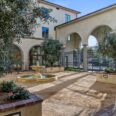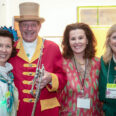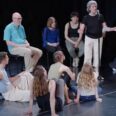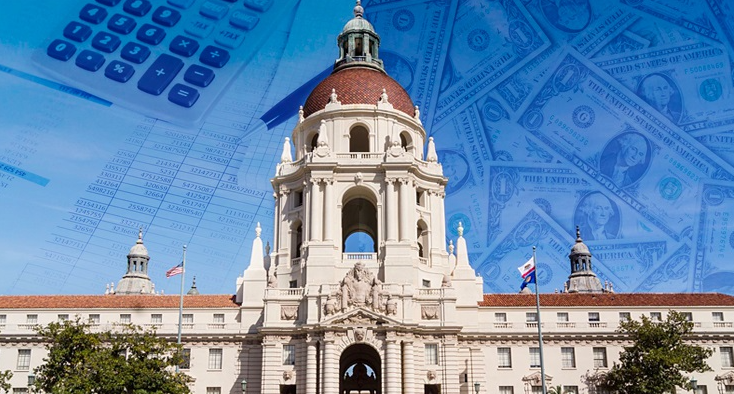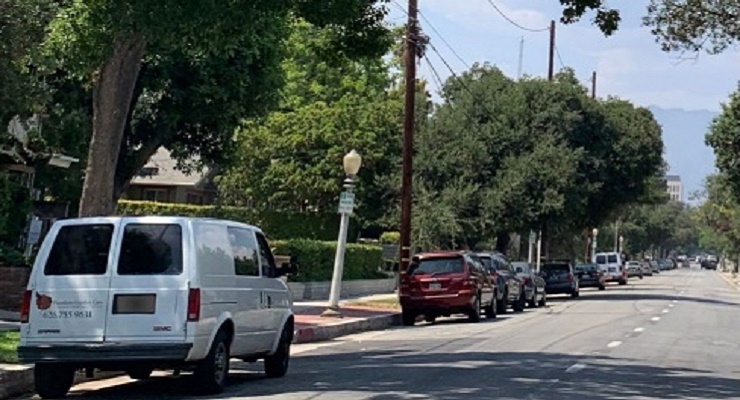
USC Pacific Asia Museum is pleased to announce “We Are Here: Contemporary Art and Asian Voices in Los Angeles,” featuring work by Reanne Estrada, Phung Huynh, Ahree Lee, Ann Le, Kaoru Mansour, Mei Xian Qiu, and Sichong Xie.
Organized by USC Pacific Asia Museum Assistant Curator Dr. Rebecca Hall, the exhibition aims to ignite understanding across geography and generation, culture and difference. These seven Los Angeles based female contemporary artists of diverse Asian Pacific heritages engage with and draw from their family’s experiences as refugees, immigrants and foreign nationals to create compelling works of art that invite visitors to think about their histories. Interwoven in their works are personal and universal narratives that give voice to the plural community… “we call home”. A variety of media will be exhibited, including painting, photography, installation, performance and video.
A second part of the exhibition, a multi-channel video installation by Tran, T. Kim-Trang, will be on view July 1 – August 2, 2020.
Reanne Estrada
Reanne Estrada’s practice includes work in drawing, sculpture, and installation as well as collaborative work in performance, video and photography. Estrada utilizes the body in space to question identity and its fragile nature. Born in the Philippines, Estrada moved with her family to California as a child. This experience emphasized the importance of community and the ways people renegotiate themselves in response to their environments. With a socially engaged artistic practice, her work explores systems and their effects on individuals as they negotiate their place in the world. For We Are Here, she has created artworks that challenge us to consider our experience of technology and surveillance and ask how we might assert greater control over our digital bodies and what is extracted from them. Exploring systems of surveillance, Estrada provides social commentary on the tenuous relationship of people to larger systems of control, using her artwork as a catalyst for public good.

Phung Huynh
Phung Huynh was born in Vietnam and came to the United States as a refugee when she was a toddler with her family. Her narrative of survival and migration is entangled in the complex history of postwar Asia, a period of upheaval, de-colonialism, reconstruction, and nationalism. Huynh’s paintings investigate notions of identity from a kaleidoscopic perspective, exploring how cultural ideas are imported, disassembled, and then reconstructed. Her recent work on view in We Are Here explores the Southeast Asian refugee experience in Los Angeles. Portraits of refugees on pink donut boxes reference the donut shops that gave Cambodian refugees an opportunity to build a new life after fleeing genocide. The sensitive portraits of refugees celebrate their power and perseverance. Cross stitch license plates with non-Western names resemble souvenir keychains, creating inclusivity and an opportunity for all Americans to find their names on these ubiquitous mementos. With this work, Huynh reveals the resilient nature of refugees in shaping the Southern California cultural landscape.
Ann Le
Ann Le was born in the United States to a refugee family from Vietnam. She uses photography to excavate her lineage within the larger context of war by revisiting her family’s experiences. Drawing from her archive of family photos and stories, familiar symbols, and research, Le creates narratives with layers of images related to real and constructed memories. Using a variety of methods including collage and illustration, she combines found and new images to touch on emigration, history, family, and conflict. Le’s photomontages reveal complex constructions that contemplate the meaning and effect of war. She adamantly conveys that those affected by war will not be silenced as they piece together new versions of themselves amid unparalleled, irreversible change.
Ahree Lee
As a child of Korean immigrants raised American, Ahree Lee looks to the past and across distances to investigate what constitutes an individual or collective identity in an increasingly diasporic, culturally alienated and fractured world. Lee uses algorithms to transform imagery like daily self-portraits, home movies, and other image archives that she finds or creates. Her work aggregates these fragments into a new sum that is greater than its parts using contemporary time-based mediums such as video, sound, and interactivity. Lee’s artworks uncover personal links to ongoing inquiries about who and what is integral to social and technological change. Her recent work investigates how invisible labor, specifically work that has traditionally been done by women, is essential to the life of economic systems. Lee’s handwoven textiles merge weaving and computer coding. Through research and process, Lee reveals a history of connection: the first computers were based on the technology of the loom. Reactivating the link between weaving and computing, Lee’s weavings and computer-generated videos draw on code, algorithms, and self-generated labor data.
Kaoru Mansour
Kaoru Mansour is a native of Japan now living in Los Angeles. She moved to California in 1986 and studied at Otis Art Institute (now Otis College of Art and Design) in Los Angeles from 1987-1989. Her experience growing up in a small village in Japan meant that nature and the seasons were integral to her life. She draws from daily life and the natural world to create balanced paintings that rediscover the joys of color, line, family, plants, and animals. Mansour plays with materials and images to create layered paintings that recall Edo period painted screens and Raku ceramics. Mansour’s collages are made up of multiple layers of pigment and collaged elements on wooden panels and canvas. The softly detailed surfaces give a sensuous appearance to the paintings and serve to elevate the subject – trees, fruit, leaves, and birds – to something revered, sacred and even mystical.
Mei Xian Qiu
Mei Xian Qiu’s complex family history directly informs her photography. Qiu was born in the town of Pekalongan on the island of Java, Indonesia, to a third-generation Chinese minority family. In the aftermath of the Chinese and Communist genocide, the family immigrated to the United States. She was moved back and forth several times between the two countries during her childhood. Drawing from her personal history, Qiu reconstructs iconic images and dissects familiar archetypes through a lens of fantastical notions of culture. These investigations into power, politics, and individual interior worlds, reflect the contemporary landscape of transience and a growing global monoculture. Qiu plays with archetypes and creates artworks that are rich in metaphor and meaning. Through photography, she speaks to the displacement she experienced as a result of her multiple heritages. Three series are featured in We Are Here; each reflects the artist’s experience traveling between China, Indonesia, and the U.S. In one series that references Mao Zedong’s speech “Let One Hundred Flowers Bloom,” the models for the imagery are Pan Asian American artists and academics specializing in Chinese culture, the very group at risk in the Hundred Flowers Movement. Another series excavates contemporary Chinese culture from a diasporic perspective and asks: How do we imagine or recover a place of origin, now distant in time, place and memory? And finally Qiu offers artworks that connect to her family’s experience in Indonesia. She cuts layers of photographs into the patterns of the batik of her childhood to uncover the dichotomy between difficult realities and the comforting fictions used to cover them.
Sichong Xie
Sichong Xie creates performance, video, and installation to explore her identity and place in the world as an expatriate Chinese citizen. She investigates the relationship between the state and the individual against various backdrops in both China and the U.S., much of her work using displaced cultural imagery within new social constructs. Xie’s practice deals with issues of identity, politics, cross-culturalism, and the surreal potential of her body in the ever-changing environment. Her recent work explores Chinese culture versus American culture and the connection between politics and family heritage. The multi-channel, multimedia installation included in We Are Here explores the impact of art and the fluidity of memory as a form of protection. Her grandmother is the family’s only witness to an event that had great effect on her grandparents: her grandfather’s political illustration, now destroyed, that landed him in prison for two years. Xie recreates the illustration many times with the aid of her grandmother’s everchanging memory. Like much of Xie’s work, this piece presents an open-ended question about survival, the stories that connect generations, and the transient nature of life.
Tran, T. Kim-Trang: Movements: Battles and Solidarity
July 1 – August 2, 2020
After the closing of part one of We Are Here, artist Tran, T. Kim-Trang will have a solo presentation as part two of the group exhibition. Her project, Movements: Battles and Solidarity, is a large-scale three-channel video installation on handmade screens. The triptych looks at significant events in the years 1972-74 regarding fashion, race, and class, particularly the Civil Rights movement in high fashion, labor unrest in the garment industry during the long 70s, and the Vietnam War. The work explores shared political and physical “movements” made manifest in the catwalk and the march.
USC Pacific Asia Museum, 46 N. Los Robles Ave., Pasadena, (626) 449-2742 or visit pacificasiamuseum.usc.edu.
About USC Pacific Asia Museum
USC Pacific Asia Museum’s mission is to create inspiring encounters with the art, history and culture of Pacific Asia that promotes intercultural understanding in the service of elevating our shared sense of humanity. Established in 1971, the museum is one of few U.S. institutions dedicated to the arts and culture of Asia and the Pacific Islands serving the city of Los Angeles and the Greater Southern California region. The museum’s historic building has served as a center for art, culture and learning in Pasadena since its construction in 1924 by pioneering collector and entrepreneur Grace Nicholson (1877-1948) as her residence and galleries. In its brief history, the museum has organized and presented a number of groundbreaking exhibitions, including the first North American exhibitions of contemporary Chinese art and the first exhibition of Aboriginal art in the United States. Exhibitions originated by the museum have traveled across the country and to Japan. The museum is also committed to scholarship and has produced more than 50 exhibition catalogues.


